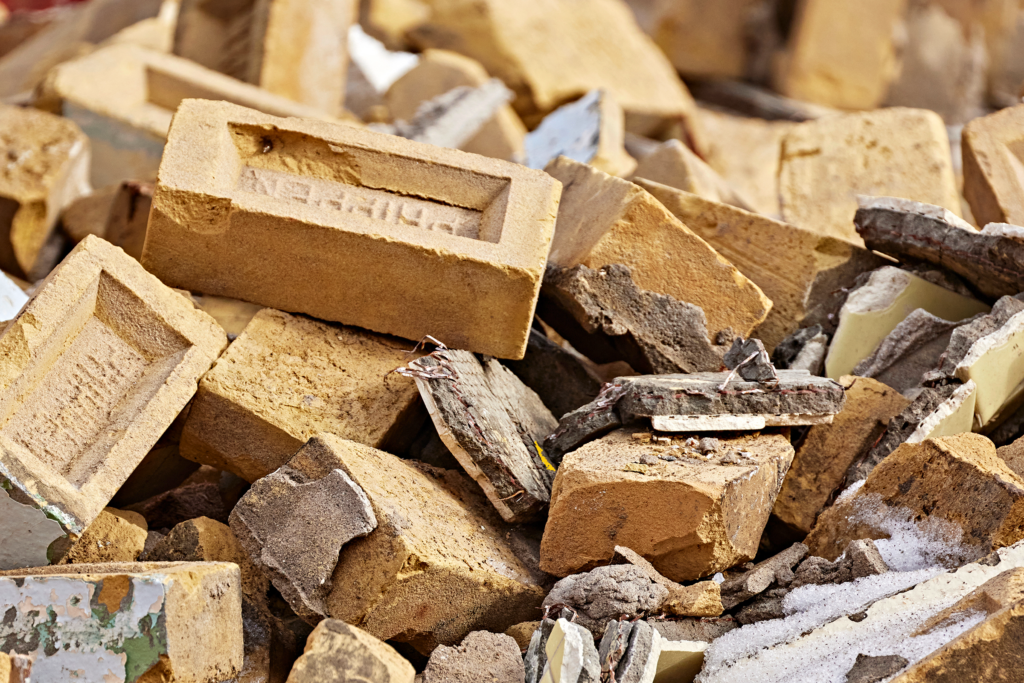At TAS, we believe that it is critical for city builders to embrace a circular economy to address pressing global challenges such as climate change, resource scarcity and pollution while promoting innovation and economic growth. That’s why we piloted a development process of material reuse at 2 Tecumseth Street, our 5-acre master-planned community in downtown Toronto.
Located in the heart of Toronto’s arts and entertainment corridor, 2 Tecumseth is an incredible new community that attempts to embrace the complexities and contradictions that make neighbourhoods great. The project is one of the last major revitalization opportunities in the downtown core. It housed a decommissioned abattoir, and is directly adjacent to the historic Wellington Destructor, a century old garbage incinerator.
In the fall of 2022, we began demolition at the site. The highlight of this effort is that we were able to divert nearly 93% of the demolition waste from landfill. That’s over 32,000 tonnes. Additionally, much of this waste (62% of the total) stayed on site, so we also avoided hundreds of tonnes of GHG (greenhouse gas) emissions from the creation of new materials and unnecessary vehicle emissions from transporting the old material to waste processing plants or landfills.
Read how we did this.
The problem of “brand-new”
As city builders, our current economic system is predicated on waste and consumption of brand-new products. We’re accustomed to discarding entire buildings when we no longer deem them useful, demolishing structures full of salvageable materials, only to recreate and purchase them again for installation in new developments. This leads to construction debris piling up in landfill (12% of national waste), and unnecessary greenhouse gas emissions are pumped into our atmosphere when replacement materials are created.
Every building material’s production process involves GHG emissions. Every cubic meter of concrete began as predominantly limestone and clay mined from a quarry by machines that use energy, fired in a kiln, and transported by vehicle to a construction site. Every wood beam was a tree harvested by machines in a forest and transported (typically by truck) to a sawmill powered by some form of energy. Reuse practices avoid the consumption of energy required to make new things when we don’t need to.

Scales of opportunity
There are two forms of reuse in the building industry: adaptively reusing entire buildings; or breaking them into their components and reusing individual materials or assemblies. Maintaining or adding to an existing building is the construction process that consumes less energy and generates the least waste. If the building absolutely cannot be reused in its current form, the next best solution is to salvage materials from it for use in another project. Both forms of reuse require upfront planning and collaboration with design, engineering, demolition and construction contractors.
TAS’s process begins at acquisition. We determine if a building can be adaptively reused, or, where we must demolish a building, we:
- quantify the materials in existing buildings, landscape elements and fixtures before starting the design process. This involves onboarding demolition or deconstruction consultants early.
- design creative ways to reintegrate existing material into our new projects, while measuring the embodied carbon avoided by doing so.
- deconstruct as much of the existing building as possible (carefully, to maintain salvageability), sorting similar materials into piles on site and cataloguing them to determine actual quantities.
- divert remaining salvaged materials from landfill.
- reintegrate salvaged materials into the new design, often in the landscape or as finishes and fixtures.

We’re piloting this process right now at 2 Tecumseth. The site includes a former municipal abattoir that could not be adaptively reused, necessitating replacement. Working through the process above with PUBLIC WORK and PDI, our team was able to salvage over 21,000 tonnes of usable material (62% of all demolition waste) to be reintegrated into the landscape of the new project. Due to the size of the site and its phasing, this process is occurring without that material ever leaving the site at all.

We recognize that this is our first attempt at material reuse in a project, and we are committed to testing this process and learning from our efforts. At the edge of the site sits, TAS’s Circular Living Lab, an upcoming experimental laboratory and exhibition space for collaboration with the Toronto Circularity Network, the Dutch-Canadian Circular Alliance, and local educational institutions to further circular design practices in the city.

Read more
- After demolition, building materials get a second life
by Alex Bozikovic, The Globe & Mail - 2 Tecumseth development by TAS has circular economy focus
by Nicholas Sokic, Sustainable Biz - Toronto developers apply circular economy principles to latest project
by David Israelson The Globe & Mail - What’s Old is New Again: Achieving Circular Economy at 2 Tecumseth
by Julian Mirabelli, Urban Toronto - TAS debuts impact measurement system to track sustainability goals
by Nicholas Sokic, Sustainable Biz - This work was highlighted in TAS’s 2022 Annual Impact Report













